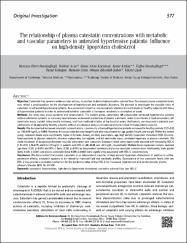The relationship of plasma catestatin concentrations with metabolic and vascular parameters in untreated hypertensive patients: Influence on high-density lipoprotein cholesterol

Göster/
Erişim
info:eu-repo/semantics/openAccessTarih
2015Yazar
Durakoğlugil, Murtaza EmreAyaz, Teslime
Kocaman, Sinan Altan
Kırbaş, Aynur
Durakoğlugil, Tuğba
Erdoğan, Turan
Çetin, Mustafa
Şahin, Osman Zikrullah
Çiçek, Yüksel
Üst veri
Tüm öğe kaydını gösterKünye
Durakoğlugil, ME., Ayaz, T., Kocaman, SA., Kırbaş, A., Durakoğlugil, T., Erdoğan, T., Çetin, M., Şahin, OZ., Çiçek, Y. (2015). The relationship of plasma catestatin concentrations with metabolic and vascular parameters in untreated hypertensive patients: Influence on high-density lipoprotein cholesterol. The Anatolian Journal of Cardiology, 15(7), 577-585.Özet
Objective: Catestatin has several cardiovascular actions, in addition to diminished sympatho-adrenal flow. Decreased plasma catestatin levels may reflect a predisposition for the development of hypertension and metabolic disorders. We planned to investigate the possible roles of catestatin in untreated hypertensive patients. As a secondary objective, we compared catestatin concentrations of healthy subjects with those of hypertensive patients in order to understand whether catestatin is increased reactively or diminished at onset. Methods: Our study was cross-sectional and observational. The patient group, comprising 109 consecutive untreated hypertensive patients without additional systemic or coronary heart disease, underwent evaluations of plasma catestatin, waist circumference, lipid parameters, left ventricular mass, carotid intima-media thickness, and flow-mediated dilation of the brachial artery. Additionally, we measured catestatin con- centrations of 38 apparently healthy subjects without any disease using a commercial enzyme-linked immunosorbent assay kit. Results: We documented increased catestatin concentrations in previously untreated hypertensive patients compared to healthy controls (2.27±0.83 vs. 1.92±0.49 ng/mL, p=0.004). However, this association became insignificant after adjustments for age, gender, height, and weight. Within the patient group, catestatin levels were significantly higher in females. Among all study parameters, age, high-density lipoprotein cholesterol (HDL-C) corre- lated positively to plasma catestatin, whereas triglycerides, hemoglobin, and left ventricular mass correlated negatively to plasma catestatin. We could not detect an association between vascular parameters and catestatin. Catestatin levels were significantly elevated with increasing HDL-C (1.91±0.37, 2.26±0.79, and 3.1±1.23 ng/mL in patients with HDL-C <40, 40-60, and >60 mg/dL, respectively). Multiple linear regression analysis revealed age (beta: 0.201, p=0.041) and HDL-C (beta: 0.390, p<0.001) as independent correlates of plasma catestatin concentration. Additionally, male gender (beta:-0.330, p=0.001) and plasma catestatin (beta: 0.299, p=0.002) were significantly associated with HDL-C concentrations. Conclusion: We documented that plasma catestatin is an independent predictor of high-density lipoprotein cholesterol. In addition to antihy- pertensive effects, catestatin appears to be related to improved lipid and metabolic profiles. Coexistence of low catestatin levels with low HDL-C may provide a probable mechanism for the predictive value of low HDL-C for increased hypertension and cardiovascular events.

















